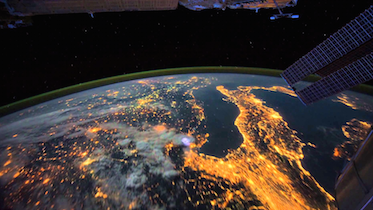 Since the end of the last Ice Age some 14,000 years ago, the Earth's human population has risen from at best a few million to well over seven billion, with projections of 9.6 billion by 2050. It is no surprise, simply by our sheer numbers, that humans have become a force of nature. (Excerpt from Chapter 1 of Climate Smart & Energy Wise)
Since the end of the last Ice Age some 14,000 years ago, the Earth's human population has risen from at best a few million to well over seven billion, with projections of 9.6 billion by 2050. It is no surprise, simply by our sheer numbers, that humans have become a force of nature. (Excerpt from Chapter 1 of Climate Smart & Energy Wise)
As mentioned in my previous post, over the coming weeks I will be previewing my forthcoming book Climate Smart & Energy Wise, which Corwin Press is publishing in late September of this year.
A critical concept for students to grasp as they begin to grapple with climate science is that humans really can have an effect at the global scale. Therefore, Chapter 1: Climate and Energy 101, reviews the basics of how humans have become a force of nature, especially in the past several centuries. When it comes to affecting the climate, it is through the burning of what Jeffrey Dukes has called "buried solar energy", a.k.a. fossil fuels, that humans have had the biggest global impact.
Ultra-concentrated fossilized forms of stored solar energy, these fuels are literally rocking the world. The book explains how burning fossil fuel in a sense reverses the process of photosynthesis. Fossil fuels are the remains of plants and microorganisms that built mass through the photosynthetic process, drawing carbon dioxide from the atmosphere and releasing oxygen. Burning them releases both energy, carbon dioxide, and other pollutants.
Burning fossil fuels are not the only way humans have an impact at the planetary scale. Chapter 1 highlights many other examples of how humans are a geologic scale force of nature including habitat destruction, the decline and extinction of species, the introduction of invasive species that change ecosystems, and alteration of the nitrogen cycle, employing industrial means to fix more nitrogen for fertilizers than all the bacteria on the planet.
Human impacts are inter-related; industrial nitrogen fixation, for example, is highly energy intensive, and the availability of cheap fertilizer can lead to overuse and run-off into waterways, with cascading effects on ecosystems. The recent algae bloom in Lake Erie, which shut down Toledo’s drinking water system for several days, was triggered at least in part by fertilizer run-off.
Chapter one also clarifies some words that we take for granted, like fire and water, light and air, that take on deeper meaning through the lens of science. Fire, for example, requires oxygen and releases carbon dioxide. Human domestication of fire for heat, cooking, and light evolved into our current practices of burning fossil fuels to turn turbines and engines.
And there is also much more then meets the eye to water, light and air as they relate to climate and energy that we need science to unlock and understand.
The chapter also points out that humans are not the first life form to have had a global impact; for much of Earth's early history there wasn't much oxygen in the atmosphere, until cyanobacteria drove the Great Oxygenation Event ~2.4 billion years ago.
In the second half of Chapter 1, I present a brief overview of the evolution of energy technology and of the study of energy in the Earth's climate system, which as early as 1896 led scientists like Svante Arrhenius to connect the dots between fossil fuel burning, increased carbon dioxide in the atmosphere, and the trapping of more infrared light and thereby the increased heating of the planet.
As I've mentioned before, here are plenty of reasons why climate and energy often haven't been taught or taught well over the years--they may fall through curricular cracks, teachers may lack the content knowledge and pedagogical confidence to teach them, and of course decades of manufactured controversy, doubt and denial have created a climate of confusion that discouraged many from teaching about them.
On top of that, climate change and energy issues can be at once depressing and overwhelming, technical and dull, making them particularly challenging to teach or learn about.
But if well presented and handled with creativity and care, climate and energy issues are ideal interdisciplinary and integrating themes, potentially linking the sciences with mathematics, language arts, geography, history, arts, social studies and civics, and at the college level, bringing in psychology, sociology, writing and rhetoric, philosophy, business…. You get the picture.
Most importantly, climate and energy are topics that are imperative to teach if we are going to effectively respond to these challenges, and make informed climate and energy decisions. In my next post, I'll delve into this more deeply in a summary of Chapter 2: Teaching (and Learning) About Climate Challenges and Energy Solutions, which inquires into the hows and whys of infusing these topics throughout the curriculum.
